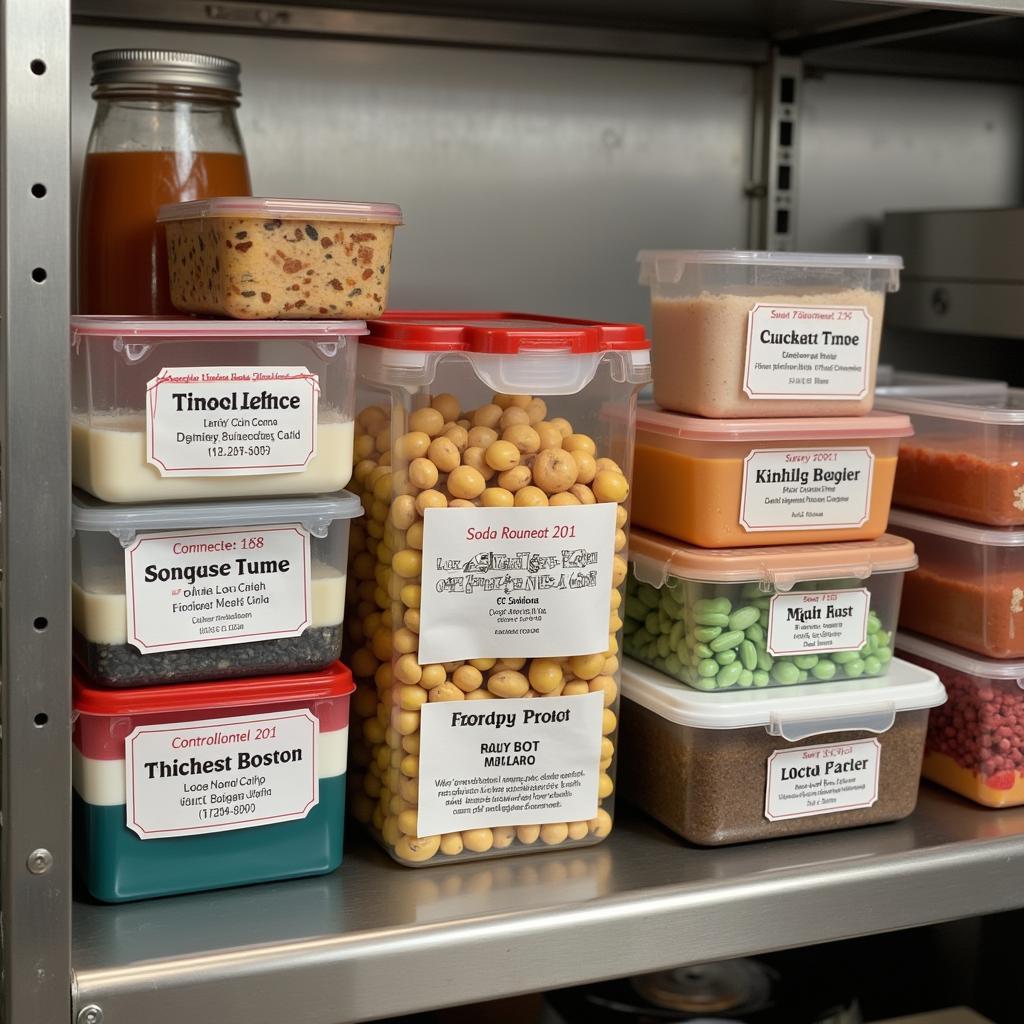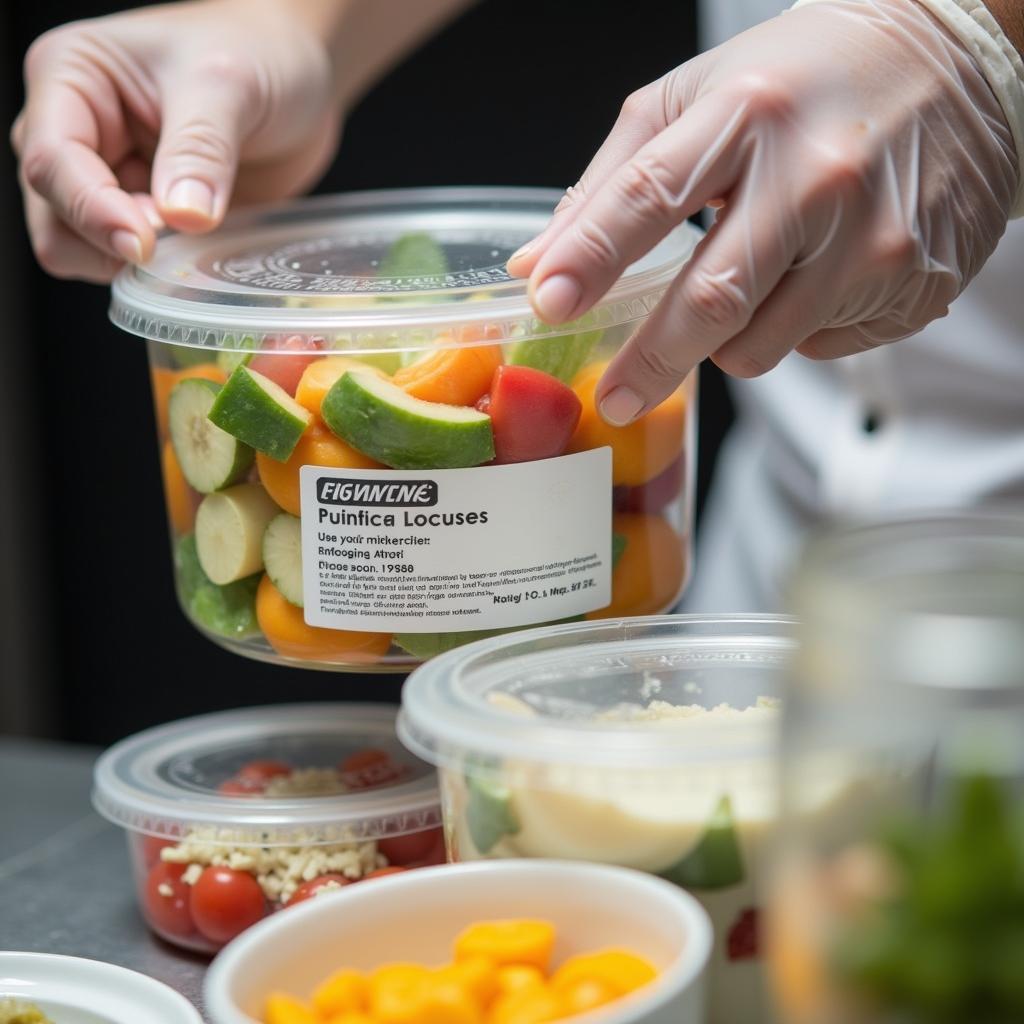Food Safe Labels are essential for maintaining hygiene and preventing cross-contamination in any food handling environment. Whether you’re a seasoned chef or simply prepping meals at home, understanding these labels is crucial for ensuring the safety and quality of your food. This guide dives deep into the world of food safe labels, exploring their importance, different types, and best practices for usage.  The Importance of Food Safe Labels
The Importance of Food Safe Labels
Understanding the Different Types of Food Safe Labels
Navigating the world of food safe labels can seem daunting, but it doesn’t have to be. From simple date labels to allergen warnings, each type serves a specific purpose. Let’s break down the most common types:
- Date Labels: These are perhaps the most familiar. They indicate when food was prepared or when it should be consumed by. Understanding the difference between “Use By,” “Best By,” and “Sell By” dates is key to minimizing food waste and maximizing safety.
- Allergen Labels: For those with food allergies, these labels are lifesavers. They clearly list any potential allergens present in the food, helping individuals make informed choices and avoid potentially dangerous reactions. Accurate and prominent allergen labeling is non-negotiable.
- Content Labels: These labels tell you exactly what’s in the food. They list ingredients, nutritional information, and sometimes even preparation instructions. They are essential for both consumers and food businesses alike.
- Storage Labels: These labels provide instructions on how to properly store food to maintain its freshness and quality. They might specify temperature requirements, storage containers, and other important handling guidelines.
- Handling Labels: Often used in professional kitchens, these labels provide instructions on how to safely handle and prepare food to prevent cross-contamination.
Why Are Food Safe Labels So Important?
Food safety is paramount.  Food Safety and Labeling Practices Food safe labels play a vital role in preventing foodborne illnesses, reducing waste, and ensuring consumers have access to accurate information about the food they eat. They are the cornerstone of responsible food handling practices.
Food Safety and Labeling Practices Food safe labels play a vital role in preventing foodborne illnesses, reducing waste, and ensuring consumers have access to accurate information about the food they eat. They are the cornerstone of responsible food handling practices.
Best Practices for Using Food Safe Labels
Effective labeling requires more than just slapping a sticker on a container. Here are some best practices to follow:
- Use Clear and Concise Language: Avoid jargon or technical terms that might confuse consumers.
- Choose the Right Label Material: Ensure the labels are durable and can withstand the storage environment (e.g., freezer, refrigerator). Consider labels for food containers for various storage needs.
- Place Labels Strategically: Make sure labels are clearly visible and easy to read.
- Regularly Check and Update Labels: Don’t let outdated labels lead to food waste or safety issues.
- Train Staff on Proper Labeling Procedures: In commercial settings, everyone handling food should understand labeling protocols.
Ensuring Compliance with Food Labeling Regulations
Food labeling regulations vary depending on your location. It’s crucial to stay informed about local and national regulations to avoid penalties and ensure consumer safety. You can explore resources like food safety stickers to help maintain compliance.
“Accurate and comprehensive food labeling isn’t just a good practice – it’s a moral imperative,” says Dr. Amelia Carter, a leading food safety expert. “It empowers consumers to make informed decisions about their health and well-being.”
What are the Common Mistakes to Avoid with Food Safe Labels?
Common mistakes include using the wrong label type, illegible handwriting, placing labels in inconspicuous locations, and neglecting to update labels regularly. Another common oversight is not considering potential allergens when labeling. Explore options like food allergy stickers to avoid these issues.
What About Using Wax Paper for Food Packaging?
Wax paper can be a great choice for certain food applications. If you’re considering this option, be sure to check out wax paper food bags for more information.
“Investing in proper labeling practices is an investment in your business and your customers’ health,” states Chef Michael Rossi, a renowned culinary consultant. “It demonstrates a commitment to quality and transparency.”
Are Dried Egg Products Safe in Dog Food?
While many dog foods contain dried egg products, it’s essential to understand their source and processing. Learn more about dried egg product in dog food to ensure your furry friend is getting safe and nutritious food.
In conclusion, food safe labels are an indispensable tool for ensuring food safety and quality. By understanding the different types of labels, implementing best practices, and staying informed about regulations, you can contribute to a safer and healthier food environment for everyone. Remember, accurate and consistent food safe labeling is not just a good practice, it’s a fundamental requirement for responsible food handling.
FAQ
- What’s the difference between “Use By” and “Best By” dates?
- Are all food allergens required to be listed on labels?
- What are the best practices for labeling food in a commercial kitchen?
- Where can I find reliable food safe label suppliers?
- How can I stay updated on food labeling regulations?
- What are the consequences of incorrect food labeling?
- Are there specific labeling requirements for different types of food establishments?
Common Scenarios for Food Safe Label Questions:
- Scenario 1: A restaurant owner wants to know the best labeling practices to ensure compliance with local regulations.
- Scenario 2: A home cook wants to learn how to properly label leftovers to avoid food waste.
- Scenario 3: A catering company needs advice on labeling food for events with guests who have allergies.
Further Exploration:
- Explore more about food storage solutions on our website.
- Learn more about food allergy management.
Need assistance? Contact us 24/7 at Phone Number: 02437655121, Email: minacones@gmail.com or visit us at 3PGH+8R9, ĐT70A, thôn Trung, Bắc Từ Liêm, Hà Nội, Việt Nam.